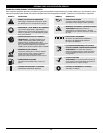
14
The recommended clearance for both intake and exhaust is
.003 – .006 in. (.076 – 0.152 mm). Use a standard automotive
.005 in. (0.127 mm) feeler gauge. The feeler gauge should slide
between the rocker arm and valve stem with a slight amount of
resistance, without binding. See Figures 37 and 38.
13. If the clearance is not within specification:
a. Turn the adjusting nut using a 5/16 inch (8 mm) wrench or
nut driver (Fig. 38).
• To increase clearance, turn the adjusting nut
counterclockwise.
• To decrease clearance, turn the adjusting nut clockwise.
b.Recheck both clearances, and adjust as necessary.
14. Reinstall the rocker arm cover using a new gasket. Torque
the screw to 20–30 in•lb (2.2–3.4 N•m).
11. Pull the starter rope slowly to bring the piston to the top of
its travel (known as top dead center). Check that:
• The piston is at the top of its travel while looking in the
spark plug hole (Fig. 37)
• Both rocker arms move
freely, and both valves are
closed.
If these statements are not true,
repeat this step.
12. Slide the feeler gauge
between the rocker arm and
the valve return spring.
Measure the clearance
between the valve stem and
rocker arm (Fig. 37 & 38).
Measure both the intake and
exhaust valves.
MAINTENANCE AND REPAIR INSTRUCTIONS
Adjust Idle Speed Screw
If, after checking the fuel and cleaning the air filter, the engine
still will not idle, adjust the idle speed screw as follows:
1. Start the engine and let it run at a high idle for a minute to
warm up. Refer to Starting/Stopping Instructions.
2. Move the throttle control to the idle position ( ) and let
the engine idle. If the engine stops, insert a small phillips
screwdriver in between the Air Filter Cover and the Engine
Cover (Fig. 33). Turn the idle speed screw in, clockwise, 1/8
of a turn at a time (as needed) until the engine idles smoothly.
Checking the fuel, cleaning the air filter, and adjusting the idle
speed should solve most engine problems. If not and all of the
following are true:
• the engine will not idle
• the engine hesitates or stalls on acceleration
• there is a loss of engine power
Have the carburetor adjusted by a Sears or other qualified
service dealer.
ROCKER ARM CLEARANCE
This requires disassembly of the engine. If you feel unsure or
unqualified to perform this, take the unit to a Sears or other
qualified service dealer
NOTE: Inspect the valve to rocker arm clearance with a feeler
gauge after the first 10 hours of operation and every
25 hours of operation.
• The engine must be cold when checking or adjusting the
rocker arm clearance.
• This task should be performed inside, in a clean, dust free
area.
1. Remove the 2 handle screws with flat blade or T20 torx head
screwdriver, while holding the nuts with 3/8” nut driver (Fig. 34).
2. Remove top bolt located near starter rope handle with
tools mentioned in step 1 (Fig. 34).
3. Loosen the 3 screws indicated in Figure 34.
4. Open vacuum door, prop open with hand.
5. Remove handle.
6. Remove the five (5) screws on the back of the engine
cover with a Flat-blade or T-25 Torx screwdriver (Fig. 35).
7. Remove the engine cover (Fig. 35).
8. Disconnect the spark plug wire.
9. Clean dirt from around the spark plug. Remove the spark
plug from the cylinder head by turning a 5/8 in. socket
counterclockwise.
10. Clean dirt from around the rocker arm cover. Remove the
screw holding the rocker arm cover with a large flat blade
screwdriver or Torx T-25 bit (Fig. 36). Remove the rocker
arm cover and gasket.
Remove
Screws
Fig. 35
View Of The Rear Engine Cover
Remove
Screws
Rocker
Arm
Cover
Fig. 36
Spark
Plug
Hole
Adjusting Nuts
Feeler Gauge
Rocker Arms
Fig. 37
INTAKE
EXHAUST
Spark Plug
Hole
Remove
Screws
Fig. 34
Loosen
Screws


















